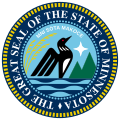| |||||||||||||||||
| |||||||||||||||||
| |||||||||||||||||
The 1857 Minnesota Secretary of State election was held on October 13, 1857, in order to elect the first Secretary of State of Minnesota upon Minnesota acquiring statehood on May 11, 1858. Democratic nominee Francis Baasen defeated Republican nominee Lucius Stannard. [1]

